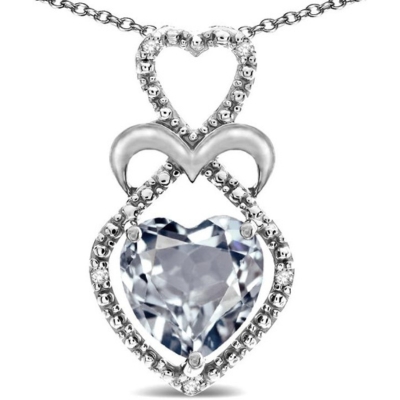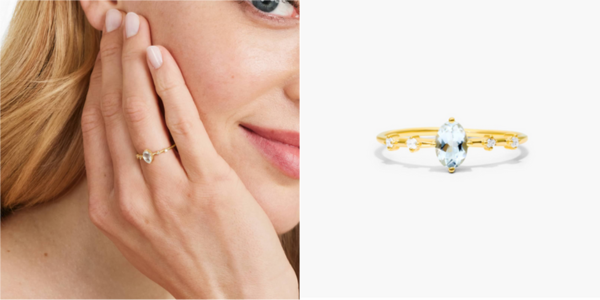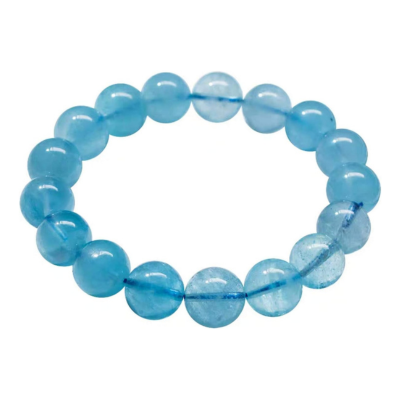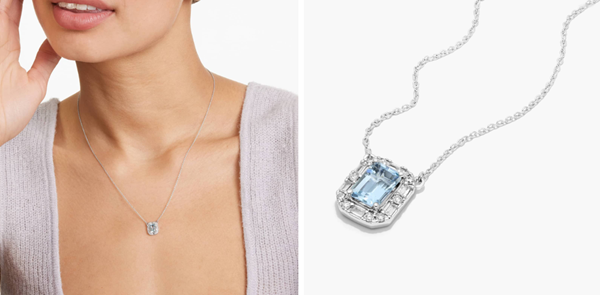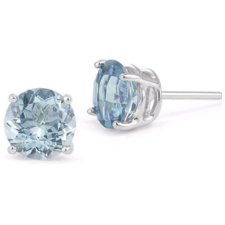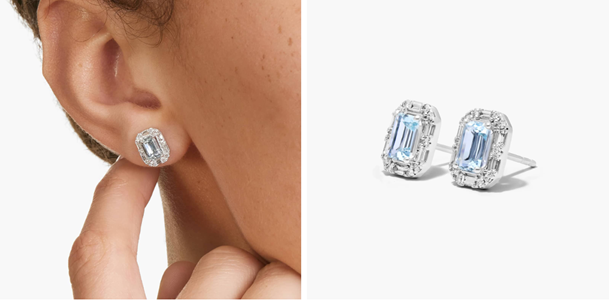What Makes Aquamarine Gems So Special? |
Aquamarine, a gemstone as captivating as the sea itself, stands out in the world of gemstones for its serene beauty and tranquility. This gemstone, with its range of blues from the lightest sky to the deepest ocean, mirrors the calming essence of water. It’s not just its stunning appearance that captivates jewelry lovers; The gem is also known for its clarity and durability, making it a popular choice for jewelry that withstands the test of time.
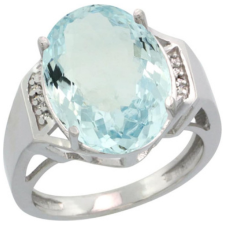
|
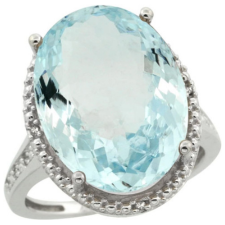
|
|
| 1 Sterling Silver Diamond Natural Aquamarine Ring Oval | 2 Sterling Silver Diamond Natural Aquamarine Ring |
Click On The Images
The word ‘aqua marina’ is Latin for seawater. Aqua means “water,” and marina means “of the sea.” The word Aquamarine comes from these Latin words.
Facts About Aquamarine:
| Mineral : | Beryl |
| Chemistry : | Be3Al2Si6O18 |
| Color : | Greenish Blue, Light In Tone |
| Refractive Index : | 1.577 to 1.583 |
| Birefringence : | 0.005 to 0.009 |
| Specific Gravity : | 2.72 |
| Mohs Hardness : | 7.5 to 8.0 |
The allure of Aquamarine goes beyond its aesthetic appeal. This gemstone is cherished for its versatility in design, effortlessly gracing everything from elegant engagement rings to statement necklaces. Its ability to complement warm and cool tones makes it a favored gem for artists and designers. Moreover, the gem’s connection to the sea makes it a symbol of protection for sailors and a token of calm and peace for wearers.
| The Rich History and Mythology Behind Aquamarine: Aquamarine carries a legacy of being treasured by ancient civilizations for its mystical properties, believed to protect sailors and symbolize purity and happiness. |
|
| Understanding the Unique Spectrum Color of Aquamarine: Renowned for its spectrum of blue hues, the presence of iron in its structure allows each stone to exhibit a unique character, especially valued for vivid, deep blue tones. |
|
| Factors That Determine the Quality and Value of Aquamarine: The Four Cs—Color, Clarity, Cut, and Carat weight—play a pivotal role in assessing aquamarine’s value. Color and clarity are particularly significant. |
|
| Choosing the Perfect Aquamarine Jewelry Piece: Selecting aquamarine jewelry involves understanding the variety of cuts that highlight the gem’s beauty, from traditional to modern designs. |
|
| How to Match Aquamarine Jewelry with Your Style: Aquamarine’s versatility makes it easy to pair with a range of colors and styles, enhancing natural allure with diverse fashion statements. |
|
| Aquamarine As a Birthstone for March: Symbolizing tranquility, purity, and renewal, aquamarine holds special significance as the birthstone for March. |
|
| Insider Tips on Caring for Your Aquamarine Jewelry: Warm soapy water and a soft brush are recommended for cleaning, while avoiding harsh chemicals and extreme temperatures to maintain its clarity and color. |
|
| Understanding the Durability and Hardness of Aquamarine: With a Mohs hardness rating between 7.5 and 8, aquamarine is durable yet susceptible to scratches and chipping. |
|
| The Fascinating Science And Geography of Aquamarine Gemstones: Aquamarine’s beauty is the result of complex geological processes, with significant sources ranging from Brazil to Africa and the United States. |
|
| Exploring Major Aquamarine Mines Around the World: Brazil is a leading source, known for large, high-quality stones. Other important regions include Pakistan, Africa, China, and the United States. |
|
| Inclusions Found In This Gemstone: Aquamarine can contain various inclusions, from mineral to liquid and gas bubbles. Some inclusions, like the unique “snowflake” inclusions, can enhance its beauty and uniqueness. |
|
| How the GIA Grades Aquamarine: Color, Clarity, Cut, and Carat Weight: The GIA assesses aquamarine based on color, clarity, cut, and carat weight, with ideal specimens showcasing a vivid blue or blue-green color and high clarity. |
The Rich History and Mythology Behind Aquamarine: |
Revered By History and Mythology:
History and mythology revere Aquamarine, and many civilizations have treasured its mystical properties and beauty. Ancient lore believed that Aquamarine was the treasure of mermaids, and sailors carried it as a talisman to ensure safe passage across stormy seas. This gemstone’s soothing blue hues were said to calm waves and protect sailors from harm.
Valued By Roman And Greeks:
The Romans and Greeks also valued Aquamarine highly, viewing it as a symbol of purity, youthful vitality, and the joy of new beginnings. They often gave it to brides at weddings as a gift to symbolize long, harmonious marriages. Beyond its protective qualities, people believed that the gem had healing powers, especially for heart, liver, and stomach conditions.
Solid 14k Gold Double Open Heart Halo Embrace Pendant Necklace
Click On The Image
Medieval Mystic’s Use in Divination:
In medieval times, mystics linked Aquamarine to the practice of divination. They used it in crystal gazing to predict the future, a testament to its deep connection with the spiritual realm. This gemstone’s historical significance deepens with its connection to the legendary philosopher’s stone, believed to provide insight into universal knowledge.
Understanding the Unique Spectrum And Color: |
Aquamarine, celebrated for its stunning range of blue hues, captivates with its spectrum from the lightest sky blue to a deep, slightly greenish blue. This gemstone’s color is usually a testament to its name, which means “seawater,” reflecting the various depths and moods of the ocean.
The blue Aquamarine, cherished for its clear, serene beauty, often exhibits a dazzling clarity, allowing light to dance through the stone, highlighting its pure, watery essence. Aquamarine’s subtle greenish-blue tint adds a unique dimension to its appearance and makes it particularly special. This slight greenish hue infuses the gem with vibrant life, mirroring the dynamic interplay between the sea and the sky.
The presence of iron within the beryl crystal structure determines the color of the gemstone. The varying concentration of iron dictates whether the stone will display more of a pure blue or a greenish-blue shade. This variation allows every piece of aquamarine jewelry to possess a unique character, with no two stones being exactly alike.
Factors That Determine the Quality and Value of Aquamarine: |
Jewelry enthusiasts celebrate this popular gemstone for its beauty and the intricate factors that define its quality and value. Understanding these factors is crucial for connoisseurs and collectors alike.
The Four Cs:
At the heart of aquamarine evaluation are the Four Cs: Color, Clarity, Cut, and Carat weight, a universally accepted method for assessing the quality of gemstones.
Color:
Exploring the Color Spectrum:
Aquamarine boasts a captivating range of hues, from deep blues to subtle greenish blues. Its color palette is relatively limited, encompassing shades from pure blue to green-blue variations. The gemstone reaches its peak value when it exhibits a rich, dark blue to slightly greenish blue hue with a strong intensity. Typically, the more vivid and pure the blue, the higher the gem’s value, though most aquamarine found naturally leans towards a lighter greenish blue tone.
The Preference for Pure Blue Aquamarine:
While a niche market exists for aquamarine’s natural greenish tint, the majority of aquamarine available commercially undergoes heat treatment. This process enhances its blue coloration, aligning with the popular demand for a more pristine blue appearance.
Size and Color Intensity:
For aquamarine to display its most striking dark colors, the stones usually need to be of a significant size—often over 5 carats. Smaller gems typically don’t achieve the same depth of color and, hence, might not be as sought after. However, exceptions exist, particularly with aquamarine from certain African locations like Nigeria, Madagascar, and Mozambique. These regions are celebrated for producing small-sized aquamarine gems that defy the norm with their intense colors, even in specimens smaller than 5 carats. Consequently, these vibrant, smaller gems can command higher prices per carat than their larger counterparts with comparable hues.
Click Here To View Above Ring: 14K White Gold Oval Aquamarine And Diamond Accent Birthstone Ring.
Enhancing Aquamarine’s Color:
A noteworthy aspect of Aquamarine is the practice of heat treatment to enhance the color. This treatment is standard and accepted in the gem industry, aiming to reduce the greenish tint and bring out a more pronounced blue color. Buyers must know that most polished aquamarine gems have undergone this stable treatment, which does not detract from the stone’s value.
Pleochroism:
One of aquamarine’s remarkable properties is its pleochroism – the ability to exhibit multiple colors when viewed from different angles. For aquamarine, this phenomenon typically presents a spectrum from nearly colorless to a deep, vivid blue. This characteristic plays a pivotal role in the cutting process of the gem. The most valuable blue hue is usually visible when the jeweler cuts the stone to align the table facet parallel to the crystal’s length, maximizing the gemstone’s weight retention and captivating blue coloration.
This strategic cutting approach, combined with aquamarine’s inherent beauty and physical properties, underscores the gemstone’s popularity and cherished status among collectors, jewelers, and gem enthusiasts.
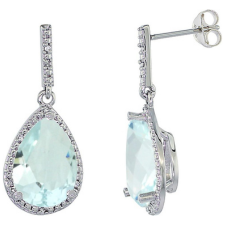
|
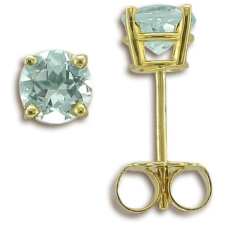
|
|
| 10K Gold Diamond Halo Natural Color Gemstone Dangle Earrings Pear Shaped | 14 Karat Yellow Gold Round Gemstone Earrings |
Click On The Images
Cut:
Versatility in Cutting Styles:
Aquamarine stands out for its adaptability in being shaped into various forms. While emerald cuts, round brilliants, and oval shapes are particularly favored, the abundance of quality rough material means that well-crafted, finely cut stones are not rare. This gemstone’s durability and clear beauty endear it to designers and artisans, who often select aquamarine for its aesthetic and functional qualities. The gemstone’s capacity for hardness and clarity makes it a preferred choice for intricate carvings and innovative gem sculptures, including fantasy cuts and decorative pieces.
Aquamarine Clarity and Inclusions:
Aquamarine is renowned for its exceptional clarity. Most of these gemstones are devoid of visible inclusions, presenting a clear, eye-clean appearance. On occasion, some aquamarine crystals may host liquid inclusions, yet these clarity characteristics are generally minimal or non-existent in finished pieces. Gemstones with noticeable inclusions are typically transformed into cabochons, beads, or intricate carvings to enhance their beauty.
14K Yellow Gold Aquamarine Oval And Diamond Birthstone Ring
Click On The Image
Understanding Aquamarine’s Flawless Nature
Aquamarine stands out for its near-perfect clarity. Its light, translucent hue offers a window into the gemstone, making it relatively easy to find pieces that are virtually flawless, especially when compared to the quest for a perfect diamond.
The Formation of Inclusions:
Despite its usual clarity, aquamarine can encounter imperfections. During its formation, the gemstone may absorb gases, liquids, and metals, leading to the creation of inclusions. These features, while often seen as flaws, add a unique touch to each stone. Jewelers and artisans strive to minimize these inclusions through careful cutting and treatment processes. A piece of aquamarine that appears cloudy or unusually dark typically harbors numerous inclusions, diminishing its appeal. However, aquamarine’s natural transparency ensures that such defects are readily apparent.
Types of Inclusions Found in Aquamarine
Aquamarine can contain a variety of inclusions, including transparent and metallic minerals like biotite, hematite, ilmenite, phlogopite, and pyrite. Other possible inclusions consist of crystal formations such as apatite, cassiterite, epidote, garnet, quartz, and tourmaline. A particularly fascinating inclusion is the “snow star,” a liquid droplet inclusion that forms a star shape within the stone. It’s crucial for buyers to inspect aquamarine gemstones carefully for these inclusions to make an informed purchase decision.
Genuine Natural Blue Aquamarine Crystal Stretch Clear Round Beads Women Men Bracelet
Click On The Image
Carat Weight:
Generally, the price per carat increases with the size of the Aquamarine because larger stones, especially those showing high color saturation and clarity, are rarer and more desirable. However, it’s interesting to note that Aquamarine has a lower price per carat than smaller, comparable gemstones due to its availability in larger sizes.
Aquamarine boasts an impressive range in size, from minuscule crystals to astonishingly large ones, with some specimens tipping the scales at up to 100 pounds (45 kilograms). While these larger stones are not uncommon, incorporating them into wearable jewelry presents a challenge, leading to lower demand, except when they serve as the centerpiece of a piece. Consequently, the price per carat for aquamarines tends to decrease for stones that exceed 25 carats in weight.
Record-Breaking Aquamarine Discoveries:
Historical finds have unearthed some remarkable aquamarine specimens. Notably, the largest aquamarine ever recorded in Brazil was discovered in 1910 in the renowned Minas Gerais region. This monumental crystal weighed an impressive 244 pounds (110 kilograms) and had dimensions of 19 inches (48 centimeters) in length and 15 inches (38 centimeters) in diameter, showcasing the extraordinary potential size of aquamarine crystals.
In conclusion, Aquamarine’s allure and value stem from its natural beauty and the meticulous considerations of the Four Cs.
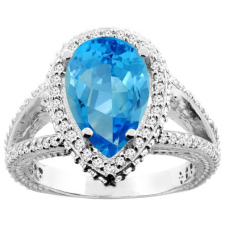
|
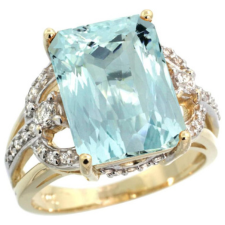
|
|
| 14K Gold Natural Aquamarine Halo Ring Pear | 14k Yellow Gold Diamond Genuine Gem Engagement Ring 0.5 ct Brilliant cut |
Click On The Images
Choosing the Perfect Aquamarine Jewelry Piece: |
Navigating Through the Variety of Aquamarine Cuts and Shapes:
The allure of aquamarine gemstones lies in their captivating hues and the variety of cuts that enhance their natural beauty. Each traditional or modern cut serves a unique purpose, accentuating different aspects of the stone’s character. Here’s an enriched exploration of the various cuts:
Emerald Cut:
A quintessential step cut, the emerald cut is celebrated for its elegant, elongated shape that highlights the Aquamarine’s clarity and color depth. This emerald cut features parallel facets that act like mirrors, enhancing the stone’s natural brilliance and allowing light to dance through the gem. However, the emerald cut’s open table (the large flat top surface) makes inclusions more visible. Consequently, you need a high-clarity stone to implement the emerald cut. This cut is not just about showcasing the gem’s serene blue; it’s about adding a layer of sophistication to any piece of jewelry.
Round or Oval Brilliants:
These cuts are the epitome of sparkle and shine. Designed to maximize light reflection, round and oval brilliant cuts are favored by gem artists looking to bring out the best in Aquamarine’s color and clarity. The round brilliant, with its symmetrical shape, offers unparalleled brightness, making it a perfect choice for engagement rings and statement pieces. On the other hand, the oval brilliant provides a more elongated look, giving the illusion of a larger size while retaining the brilliance of a round cut. These cuts are ideal for those who desire the Aquamarine to be the focal point of their jewelry, radiating light and color from every angle.
14K White Gold Allure Diamond Halo Aquamarine Necklace
Click On The Image
Step-Cut Designs:
Beyond the emerald cut, step cuts like the baguette cut also celebrate the Aquamarine’s color. These cuts feature steps of parallel facets that create a hall-of-mirrors effect, enhancing the stone’s color saturation and clarity. The baguette cut, often used as side stones, offers a sleek, modern look that complements the central gemstone in a piece of jewelry. Step cuts are about precision and geometry, creating a structured beauty that draws the eye into the gemstone’s depth.
Other Fancy Cuts:
Gemsmiths design cuts like the cushion and oval to showcase the Aquamarine’s color with a touch of whimsy. The cushion cut, with its rounded corners and larger facets, combines the brilliance of a round cut with the unique shape of a square or rectangle, making it an increasingly popular choice for those seeking a vintage feel with modern performance. The oval cut shares similar benefits, providing a flattering, elongated shape that enhances the wearer’s hand while offering the sparkle of a round cut.
Marquise, Pear, and Princess Cuts:
These cuts add diversity to the Aquamarine’s presentation. With its pointed ends, the marquise cut creates an illusion of length, making it a stunning choice for maximizing carat weight and adding a touch of elegance. The pear cut, a combination of round and marquise shapes, offers versatility in styling, perfect for unique engagement rings or pendants. The princess cut, known for its sharp corners and square shape, brings a contemporary edge to the Aquamarine, highlighting its color and brilliance in a modern setting.
Each cut of Aquamarine offers a unique way to celebrate this gemstone’s natural beauty, from the reflective elegance of steep cuts to the dazzling brilliance of round and oval cuts and the unique charm of fancy shapes. By understanding the characteristics and appeal of each cut, enthusiasts can select aquamarine jewelry that highlights the gemstone’s best features and complements their style.
7mm Aquamarine Stud Earrings Platinum Setting Screw Back Posts
Click On The Image
How to Match Jewelry with Your Style: |
Here are some insightful ways to incorporate this beautiful stone into your wardrobe, drawing on inspiration from various sources.
Color Coordination is Key:
Aquamarine’s light blue hue pairs beautifully with a range of colors. Consider garments in navy, midnight blue, lavender, aubergine, dusty rose, and peach for a harmonious look. These colors complement Aquamarine’s cool tones, creating an effortlessly chic ensemble.
Reflect Gemstone Cuts in Your Outfit:
Aquamarine comes in various cuts and shapes, offering a unique opportunity to match your jewelry with the patterns and designs of your clothing. For instance, if pear-shaped aquamarine pieces draw your attention, you might choose garments or accessories with teardrop motifs to echo this shape, creating a cohesive and thoughtfully curated look.
Jewelry Ensemble Harmony:
Click Here To See The Ring in Above Video: 14K Yellow Gold 1.8mm Petite Single Aquamarine Birthstone Ring
When selecting aquamarine jewelry, consider how the piece interacts with the rest of your jewelry collection. Aquamarine pairs exceptionally well with silver or white gold, offering a cool, refined look. Complementary gemstones like blue topaz and turquoise can create a stunning, cohesive blue palette. At the same time, purple and green gems pair well with Aquamarine, adding a pop of color to your ensemble.
Embrace the Psychology of Colors:
Aquamarine evokes feelings of relaxation, weightlessness, and purity. Its soft blue shade promotes peacefulness and trust, making it a perfect addition to jewelry pieces intended to soothe and inspire. Consider incorporating Aquamarine into designs that reflect its calming properties, such as a Triple Ocean Waves necklace or Aqua Drops earrings that capture the essence of gentle waves and soft feathers floating in the air.
Explore Versatile Jewelry Designs:
Aquamarine’s versatility is showcased in various jewelry pieces, from marquise-shaped rings to cluster Y necklaces and mermaid earrings. These designs offer a range of options to suit different tastes and occasions, whether you’re looking for a subtle touch of color or a statement piece.
Incorporating Aquamarine into your jewelry collection allows you to explore the interplay of color, shape, and style, enhancing your style with a gemstone known for its beauty and calming influence. Whether you’re dressing for a casual outing or a formal event, aquamarine jewelry adds a touch of sophistication and serenity to any outfit.
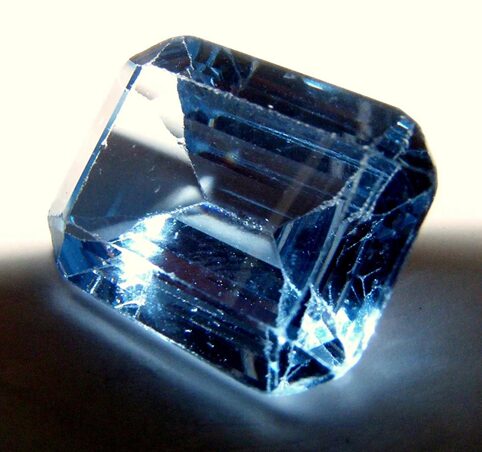
|
Aquamarine As a Birthstone for March: |
Rich in history and symbolism, birthstones are treasured gifts that transcend mere birthday or anniversary presents. Gem aficionados trace these gems with unique properties and powers back to the Breastplate of Aaron, as described in the Book of Exodus. This breastplate featured twelve gems representing the twelve tribes of Israel, symbolizing their unique attributes.
Aquamarine is the birthstone for March, symbolizing tranquility, purity, and bravery. This gemstone, with its shades of blue that mirror the sea, is believed to protect its wearer, offering a sense of calm and courage. Aquamarine’s connection to water is also thought to bring harmony and clarity to those who wear it, making it a cherished stone for individuals born in March.
The connection between these stones and the twelve zodiac signs was first made by scholars like Flavius Josephus and St. Jerome, setting the stage for the birth month assignment tradition that emerged in 18th-century Poland. In 1912, the National Association of Jewelers standardized the list of birthstones, creating the modern, traditional, and ancient lists that guide today’s choices.
Here’s a brief overview of the birthstones for each month across the modern, traditional, and ancient categories:
| Month | Modern | Traditional | Ancient |
|---|---|---|---|
| January | Garnet | Garnet | Garnet |
| February | Amethyst | Amethyst | Amethyst |
| March | Aquamarine | Bloodstone | Aquamarine/Bloodstone |
| April | Diamond | Diamond | Diamond |
| May | Emerald | Emerald | Emerald |
| June | Pearl/Alexandrite | Alexandrite | Moonstone |
| July | Ruby | Ruby | Ruby |
| August | Peridot/Spinel | Sardonyx | Peridot |
| September | Sapphire | Sapphire | Sapphire |
| October | Opal/Tourmaline | Tourmaline | Opal |
| November | Topaz/Citrine | Citrine | Topaz |
| December | Turquoise/Blue Topaz | Zircon | Turquoise |
Aquamarine, the stunning gemstone known for its shades ranging from the deepest blues to the lightest hints of green, is the birthstone for March. This gem is not only celebrated for its breathtaking beauty but also for its rich history and symbolic meanings.
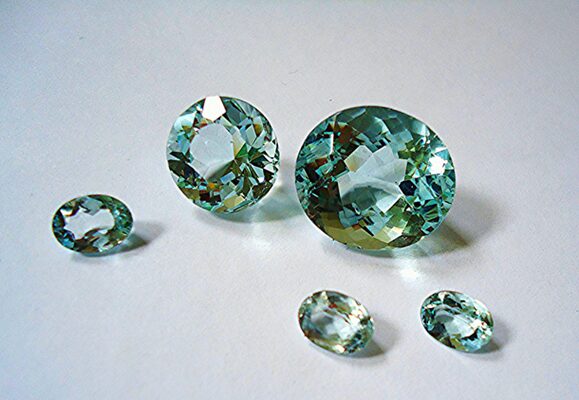
|
|
Aquamarines. Photo by Mauro Cateb.. Licensed under CC By 2.0. |
Insider Tips on Caring for Your Aquamarine Jewelry: |
Proper Cleaning and Maintenance Techniques for Aquamarine:
Aquamarine, the enchanting March birthstone, embodies the serene blues and greens of the sea. Its allure is undeniable, but like all precious gems, it requires proper care to maintain its sparkle and beauty. Here are essential tips for the cleaning and maintenance of aquamarine jewelry.
Warm, Soapy Water and a Soft Brush:
The safest and most effective way to clean aquamarine jewelry is to use warm, soapy water and a soft brush. Mix mild dish soap with lukewarm water, and gently scrub the aquamarine surface and setting with a soft-bristled brush. This method effectively removes dirt and grime without harming the stone.
Rinsing and Drying:
After cleaning, rinse your aquamarine jewelry thoroughly in lukewarm water to remove any soap residue. Washing off all soap is crucial because residue can dull the gemstone’s appearance. Dry the piece with a soft, lint-free cloth, ensuring it’s completely dry before storage or wear.
Click On The Link To View The Ring In The Above Video: 14K White Gold Infinity Aquamarine Birthstone Ring
Avoid Harsh Chemicals:
Aquamarine can be sensitive to harsh chemicals. Exposure to chemicals like chlorine, alcohol, and ammonia can damage the gemstone’s surface. Removing aquamarine jewelry before using household cleaners or swimming in chlorinated water is advisable.
Regular Inspections:
A professional jeweler can help maintain the integrity of your aquamarine jewelry through regular inspections. They can check for loose settings or signs of wear and tear, ensuring your jewelry remains in excellent condition.
Storage:
Store aquamarine jewelry separately from other gemstones to prevent scratches. A fabric-lined jewelry box with compartments or individual soft pouches is ideal for keeping each piece safe and secure.
Avoid Extreme Temperatures:
Sudden temperature changes can affect Aquamarine. Avoid exposing the stone to extreme heat or cold, which could cause cracks or fractures. It’s also wise to keep it away from direct sunlight for prolonged periods, as intense light can fade the color of some gemstones.
Following these straightforward but effective care and maintenance tips, your aquamarine jewelry will continue to captivate with its oceanic hues for years. Remember, a little care goes a long way in preserving the beauty and longevity of your precious March birthstone treasures.
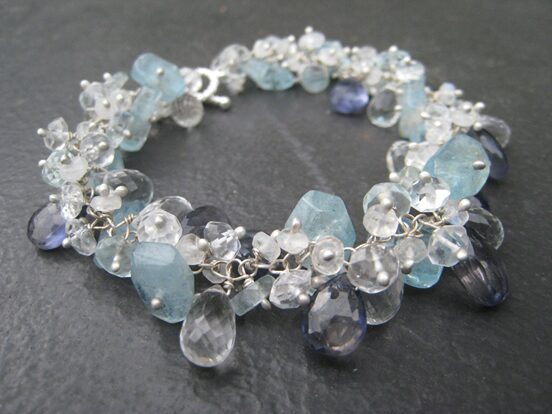
|
|
Built Around Antarctica’s Icy Shades, This Bracelet Blends Iolites, Moonstones, Rock Crystals, And Soft Blue Aquamarines. Photo by Marianne Madden. Licensed under CC By-SA 2.0. |
Understanding the Durability and Hardness of Aquamarine: |
Aquamarine is a variety of beryl, the same mineral family as emerald. When it comes to jewelry, understanding a gemstone’s durability and hardness is crucial for proper care and maintenance.
Durability: Aquamarine is a durable gemstone, making it suitable for everyday wear. However, its durability does not render it immune to damage. Aquamarine can be prone to scratching, chipping, or even cracking upon impact with a harder material or surface.
Hardness: On the Mohs scale of mineral hardness, Aquamarine ranks between 7.5 and 8. This hardness means that while it is relatively hard and resistant to scratches from softer substances, harder materials like diamonds or sapphires can still scratch it. Its hardness level also means that aquamarine jewelry can maintain its polish and luster for a long time with proper care.
Care Tips: Link to the previous section.
The Fascinating Science And Geography of Aquamarine Gemstones: |
From Beryl to Beauty: How Nature Cooks The Aquamarine Gems:
Aquamarine, a gemstone celebrated for its dazzling sea-blue colors, is a testament to nature’s artistry. This gemstone, a variety of beryl, owes its captivating hues to the intricate processes beneath the Earth’s surface.
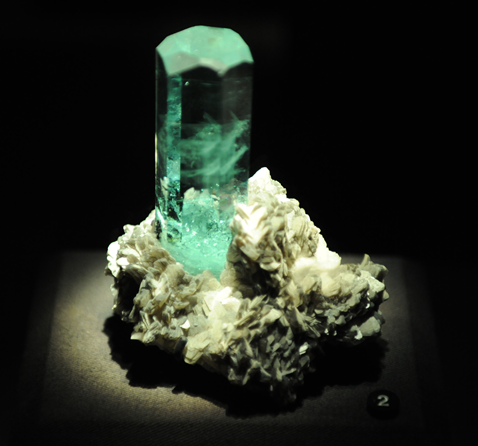
|
|
Aquamarine crystal. Photo by Ed Uthman. Licensed under CC By 2.0. |
Formation Process:
Aquamarine forms deep within the Earth’s crust under high temperature and pressure conditions. It primarily occurs in pegmatites, igneous rocks that form in the final stages of magma cooling. Trace amounts of iron, incorporated into the beryl crystal structure during formation, give Aquamarine its greenish natural color.
Geographical Distribution:
Aquamarine can be found in numerous locations around the globe, each contributing unique shades and qualities to the gemstones mined there. Nigeria, Madagascar, Zambia, Pakistan, and the United States, particularly in Colorado, are significant sources of Aquamarine. Brazil is also an important supplier, including the region that yielded the famous Dom Pedro Aquamarine.
Mineral Composition:
As a mineral, Aquamarine is part of the beryl family, a Beryllium Aluminum Silicate with the general chemical formula Be3Al2(Si16O18), which also includes other gemstones like emeralds. What distinguishes Aquamarine is its clarity and range of blue to greenish-blue colors. Iron within the crystal lattice is responsible for its color, which can vary from a pale blue to a deep sea blue, often influenced by the concentration of iron.
Color Variations:
The most prized aquamarine gems exhibit a deep, vivid blue, often achieved through heat treatment. This process enhances the blue hue while diminishing the greenish aspects, resulting in gems that capture the essence of tropical seas. Despite this enhancement, the natural beauty of rough Aquamarine, with its subtle color gradients, is undeniable.
Physical Properties:
With a hardness rating of 7.5 to 8 on the Mohs scale, Aquamarine is durable enough for daily wear. This innate hardness makes it an excellent choice for various types of jewelry, from rings and earrings to pendants and bracelets.
Caring for Aquamarine:
To maintain the beauty of aquamarine gemstones, cleaning with warm, soapy water and a soft brush is recommended. This gentle method removes dirt and oils without damaging the stone.
Aquamarine’s journey from beryl to beauty is a fascinating tale of geological processes and elemental influences. Its widespread availability across continents further adds to the allure of this gemstone, making it a cherished addition to any jewelry collection. Whether in its polished form or as rough Aquamarine, the gem continues to captivate with its serene hues and crystalline clarity.
14K White Gold Allure Diamond Halo Aquamarine Earrings
Click On The Image
Exploring Major Aquamarine Mines Around the World: |
Brazil – The Premier Source:
Brazil is the most important source of Aquamarine, renowned for producing large quantities of high-quality gemstones. The mines in the Brazilian states of Minas Gerais and Bahia are particularly famous. The Dom Pedro aquamarine, the largest cut aquamarine gem in the world, was mined in Minas Gerais. Gem lovers celebrate Brazilian aquamarines for their size, clarity, and rich blue colors.
Pakistan – High-altitude Treasures:
The northern regions of Pakistan, especially in the Gilgit-Baltistan area, are known for yielding exceptional aquamarine crystals mined at high altitudes in the Karakoram mountain range. The jewelry world prizes Pakistani aquamarines for their vibrant colors and clarity. The challenging terrain and remote locations of these mines add to the allure and value of the gems extracted.
Africa – Diverse Sources:
Africa is home to several significant aquamarine mines, with countries like Madagascar, Mozambique, Nigeria, and Zambia being notable contributors. Each African country produces Aquamarine with distinct characteristics. For example, Mozambique is known for its dark blue aquamarines, while Nigerian aquamarines tend to have a lighter, more subtle hue.
China – A Growing Contributor:
In recent years, China has emerged as a vital source of Aquamarine. In particular, the mines in the Yunnan province have been producing appreciable Aquamarine for its quality and color. While less well-known than Brazil or Pakistan for aquamarine mining, China’s contribution to the market is steadily growing.
United States – Historical and Current Production:
The United States, particularly Colorado, has a history of aquamarine mining. Mount Antero in the Rocky Mountains is famous among mineral collectors for its Aquamarine finds. While the U.S. is not a significant producer on the scale of Brazil or Africa, the quality of the Aquamarine from this region has a unique appeal.
Inclusions Found In Aquamarine: |
Inclusions Found In This Gemstone:
Here are some of the most common types of inclusions seen in Aquamarine:
Mineral inclusions:
These are the most common types of inclusion in Aquamarine and can include minerals like mica, hematite, ilmenite, apatite, garnet, and tourmaline. They can appear as tiny flakes, needles, or even crystals and be black, brown, white, or red.
Liquid inclusions:
These are tiny pockets of fluid trapped within the Aquamarine. Water, salt water, or even gas can fill these tiny pockets of fluid trapped within the Aquamarine. Like the famous “snowflake” inclusions in some Brazilian aquamarine, liquid inclusions can sometimes form unique patterns.
Gas bubbles:
These are small pockets of air trapped within the Aquamarine. Usually colorless and transparent, a loupe can sometimes reveal them. The presence and type of inclusions in Aquamarine can affect its value. Generally, stones with fewer and less noticeable inclusions are considered more valuable. However, some inclusions are desirable, such as the “snowflake” inclusions, which can add to the beauty and uniqueness of the stone.
Ultimately, whether an inclusion is considered a flaw or a feature depends on the individual’s preference. Some people prefer an aquamarine’s clean, flawless look, while others appreciate the natural beauty and character that inclusions can add.
How the GIA Grades Aquamarine: Color, Clarity, Cut, and Carat Weight: |
Color:
The allure of Aquamarine lies mainly in its captivating color palette, which spans from blue to slightly greenish blue. The most sought-after hue is a deep blue, often with a slight greenish tint, which commands the highest value. This color is especially striking in stones over five carats, showcasing a moderately strong intensity and a uniform appearance. The color grading considers the hue’s purity and intensity, with the ideal being a vivid, even coloration without zoning. Aquamarines generally exhibit a light greenish-blue tone. The market particularly prizes gems that are heat-treated to enhance their blue color.
The Role Of Heat in Enhancing Color:
Aquamarines generally exhibit a light greenish-blue tone. The role of heat treatment is pivotal in enhancing the blue coloration of aquamarines. Many aquamarines undergo heat treatment to reduce greenish tones, resulting in a purer blue color that is more valuable and sought after in the market. This treatment is standard and accepted within the industry, as it stabilizes the stone’s color.
Clarity:
Clarity is another critical factor in grading aquamarine. Most aquamarines used in jewelry are eye-clean, meaning they lack visible inclusions to the naked eye. The gemstones might contain minor liquid inclusions, but significant imperfections are rare, making high clarity a common trait among faceted aquamarines. Lapidaries carve stones featuring noticeable inclusions into cabochons, beads, or carvings instead of faceted stones.
Cut:
Aquamarine’s versatility in cutting shapes is well-acknowledged, with popular forms including emerald cuts, round brilliants, and oval shapes. The cutting process aims to accentuate the gem’s pleochroism—its ability to display different colors when viewed from different angles—enhancing its blue hue to the fullest. This strategic cutting results in the exquisite presentation of Aquamarine’s natural color and clarity.
Carat Weight:
Size significantly influences Aquamarine’s grading, with larger stones typically displaying deeper, more intense colors. Fine-quality aquamarines are in various sizes, including large aquamarines over 25 carats. However, smaller aquamarines, particularly those under five carats, may exhibit less saturation and, thus, a lighter color. Gems from specific African mines stand out for their rich color even in smaller sizes, often fetching higher prices per carat than larger stones of a similar color.
In summary, the Gemological Institute of America (GIA) grades Aquamarine based on a comprehensive evaluation of its color, clarity, cut, and carat weight. Each factor is vital in determining the gemstone’s quality and value. The ideal Aquamarine exhibits a vibrant, even blue or blue-green color, high clarity, a well-executed cut that maximizes the stone’s natural beauty, and a significant size that enhances its color’s intensity.
See More Gemstones As Follows
